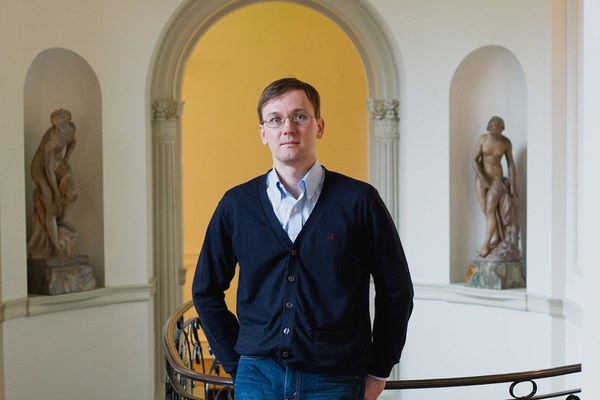Alexandre Tokovinine, assistant professor of anthropology at the University of Alabama, was a fellow in Pre-Columbian Studies in spring 2019. His research report, “Little Kings: Minor Royal Dynasties of the Classic Maya,” began to synthesize the ancient Maya world’s many middle-range kingdoms and explain their role in the geopolitical landscape.
Q&A with Alexandre Tokovinine
Why did little kings matter, and why was it dangerous to be one?
Most people who have read something about the Maya would tell you that the ancient Maya had city-states. They are often imagining the top 12 royal families, in places like Palenque, Yaxchilán, Tikal, Copan, Calakmul. Those were the most successful, the most powerful, the most influential royal families—in many ways the trendsetters of the Maya political world.
But the bulk of the landscape consisted of much smaller royal courts. On one end of the political spectrum, you had places like Tikal, a city of more than 100,000, and on the other end you had Holmul, where I work, where perhaps only a couple of thousand people lived. For every great kingdom, for every great royal house, there were dozens of tiny ones connected in economic and sociopolitical networks. If the little guys failed, the big ones failed too, and vice versa.
Part of my project is to understand those connections from the viewpoint of the little kings. For example, the royal courts at Baking Pot and Buena Vista del Cayo were technically kingdoms of their own. But because of their obligations as vassals to larger royal families, they had to send their men to wars, waste resources that may have been better spent internally. If they chose not to fight, they perhaps faced extreme violence in retribution.
Occasionally smaller kingdoms rose to the global level. For example, Motul de San José had the most distinguished art school for pottery production in the southern Maya lowlands. Their artists were some of the few who actually signed their work—for example, the drinking cup in the Dumbarton Oaks collection. Some little kings were able to extend their influence way beyond the boundaries of the polity.
Above all, the fate of smaller kingdoms depended on what was going on around them. As archaeologists, we’re often compelled to look at our site and imagine that what we see is essentially internal: local tensions related to the local economy and sociopolitical context. But the reality is very different. Most of our polities, even though it is very difficult to trace archaeologically, were part of a global network of alliances and dependencies and conflicts between royal families. This global landscape is the most defining factor in why certain places succeed or fail.
How did that global landscape affect everyday people living in smaller kingdoms?
Witzna, one of the Guatemalan sites where I work with the Holmul Regional Project, was attacked by the city of Naranjo and completely burnt down in the 7th century. Presumably the failure of the local royal court at Witzna precipitated an extreme response—probably from its former overlords in Naranjo—that led to the destruction of the entire landscape and affected nearly everyone in the city. Their fields, houses, and gardens (something we know Maya farmers invested in for generations) were burned. Everything was destroyed. Sedimental data suggests abandonment for several decades after the fire. It’s a great example of how the failure of local rulers would then, given the global political landscape, affect the normal person. Recently this research was featured in the media.
In your talk, you mentioned a panel in the Dumbarton Oaks collection. What does it reveal about smaller Mayan kingdoms?
I was privileged to contribute an entry on the panel, which probably came from the Lacanha site in Mexico, to the catalogue Ancient Maya Art at Dumbarton Oaks. The panel is a curious document depicting a provincial governor who is noble, but definitely not a king. A nobleman’s authority came from the body of the king, who was the chief intermediary between the gods, ancestors, and living human beings. Kings had something in their blood that gave them the right to rule.
But we know from famous monuments at Bonampak that the governor’s son became king! Presumably he did so by marrying a queen, then tried to retrospectively promote his dad to kingship. Things fell apart when he tried to marry for a second time—the marriage deal came with an offer he could not refuse from the more powerful and assertive city of Yaxchilán—because the new children would no longer have a single drop of the local royal blood. (We can only speculate about what actually happened, because once things started falling apart, there was nobody to leave any inscriptions with explanations.)
Exceptions to the rules show us that there were rules: very clear boundaries within the social fabric of ancient Maya life and politics. Those rules were important regardless of the scale of the royal court. But they are especially significant for understanding how small royal courts worked—when there wasn’t much physical and personal distance between the royal household and the households around it, and the difference between nobles and commoners was blurry.
Julia Ostmann is postgraduate writing and reporting fellow at Dumbarton Oaks. Photo by Elizabeth Muñoz Huber, postgraduate digital media fellow.

